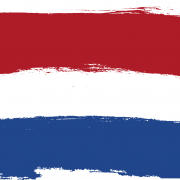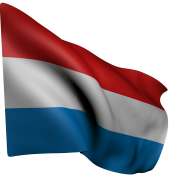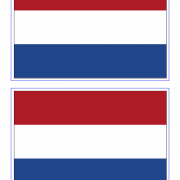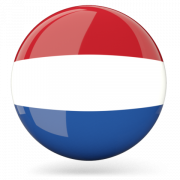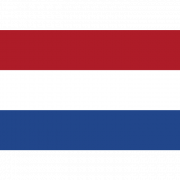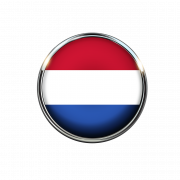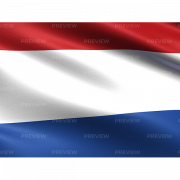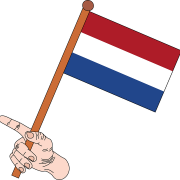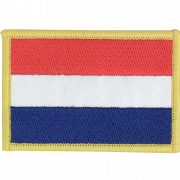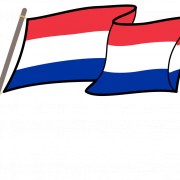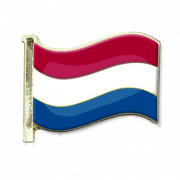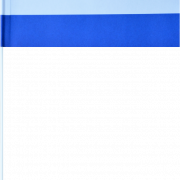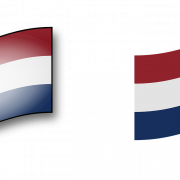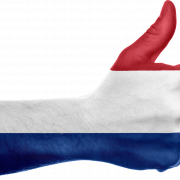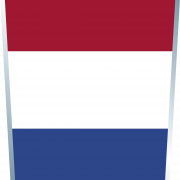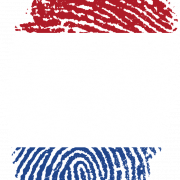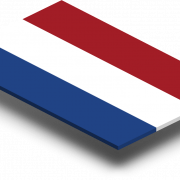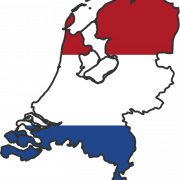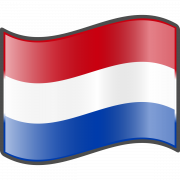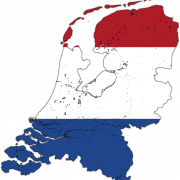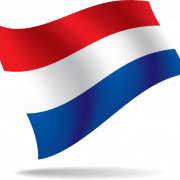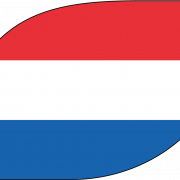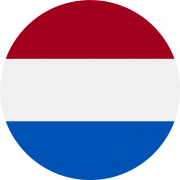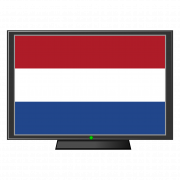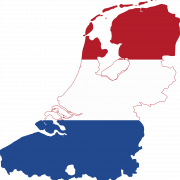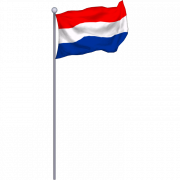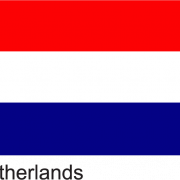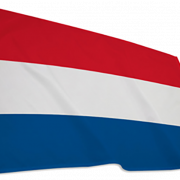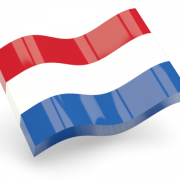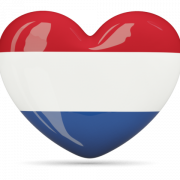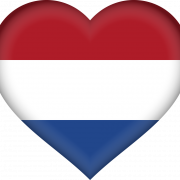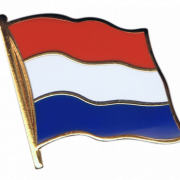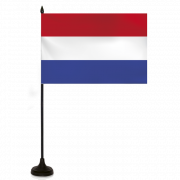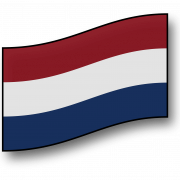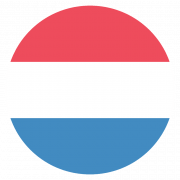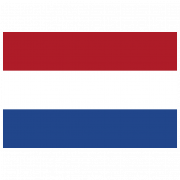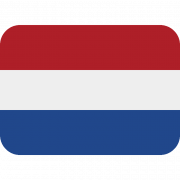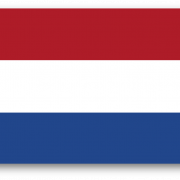Download top and best high-quality free Netherlands Flag PNG Transparent Images backgrounds available in various sizes. To view the full PNG size resolution click on any of the below image thumbnail.
License Info: Creative Commons 4.0 BY-NC
The Netherlands’ flag (Dutch: de Nederlandse vlag) is a horizontal red, white, and blue tricolor. The current design is a variation of the late 16th century orange-white-blue Prinsenvlag (“Prince’s Flag”), which evolved into the red-white-blue Statenvlag (“States Flag”), the naval flag of the States-General of the Dutch Republic in the early 17th century, making the Dutch flag perhaps the oldest tricolor flag in continuous use. The Russian and French flags are also based on it. During the 1930s economic crisis, the ancient Prince’s Flag, which was orange in color, earned some favor among some individuals. The colors red, white, and blue and their formal position as the national flag of the Kingdom of the Netherlands were affirmed by royal decree on February 19, 1937, to clear up any doubt.
The Netherlands’ national flag is a tricolor flag. The horizontal fesses are equal-sized stripes of red (officially defined as a “bright vermilion”), white (silver), and blue from top to bottom (“cobalt blue”). The dimensions of the flag (width: length) are 2:3. The color parameters were specified by the NEN (former HCNN) in November 1958 as follows:
Colors are specified in this definition using the CIE-1931 color space and Standard illuminant C at a 45° angle.
The Dutch flag is nearly identical to Luxembourg’s, except that it is shorter and has a deeper shade of red and blue stripes. The closeness of the two flags has sparked a nationwide discussion over changing Luxembourg’s flag, which Michel Wolter started in 2006.
When the majority of the Netherlands provinces were united under the Duke of Burgundy at the end of the 15th century, the Duke of Burgundy’s Cross of Burgundy Flag, which consisted of a red saltire resembling two crossed, roughly-pruned (knotted) branches on a white field, was used for joint expeditions. This flag was kept in use by the subsequent House of Habsburg.
The provinces of the Low Countries rose in revolt against King Philip II of Spain in 1568, and Prince William of Orange (1533–1584) led the insurgents. The House of Orange’s etymology has nothing to do with the name of the fruit or the color orange. The colors orange, white, and blue (Dutch: Oranje, Wit, Blauw, from French Orange, Blanc, Bleu) were first used at the siege of Leiden in 1574 when Dutch officers donned orange-white-blue brassards. In 1575, the first full-color representation of the flag was published. When William arrived in Ghent in 1577, he was greeted by various theatrical allegories performed by a little girl dressed in orange, blue, and white. The ordinances of the Admiralty of Zeeland, dated 1587, i.e., shortly after William’s death, including the first specific mention to a naval flag in these colors.
In 1972, the Netherlands issued a postage stamp to celebrate the 400th anniversary of the establishment of the Dutch flag. The earliest Dutch flag is thought to have been made up of the colors orange, white, and blue. That was founded on the fact that in 1572, the pro-Dutch privateers Watergeuzen (Gueux de Mer, “Sea Beggars”) captured Den Briel in the name of William, Prince of Orange. However, it is unknown if they carried an orange-white-blue flag with them to the occasion. However, they did begin using an orange-white-blue tricolor in the 1570s. It was eventually termed the Prinsenvlag (“Prince’s flag”). It served as the inspiration for the old South African flag, New York City and Albany, all of which were former Dutch Republic dominions.
Download Netherlands Flag PNG images transparent gallery.
- Netherlands Flag PNG Free Image
Resolution: 2001 × 1078
Size: 179 KB
Image Format: .png
Download
- Waving Netherlands Flag PNG Clipart
Resolution: 957 × 720
Size: 317 KB
Image Format: .png
Download
- Netherlands Flag PNG File
Resolution: 2480 × 3508
Size: 42 KB
Image Format: .png
Download
- Round Netherlands Flag Transparent
Resolution: 640 × 480
Size: 113 KB
Image Format: .png
Download
- Vector Netherlands Flag PNG Free Download
Resolution: 700 × 700
Size: 5 KB
Image Format: .png
Download
- Vector Netherlands Flag PNG Picture
Resolution: 640 × 480
Size: 62 KB
Image Format: .png
Download
- Round Netherlands Flag PNG Clipart
Resolution: 1280 × 1280
Size: 342 KB
Image Format: .png
Download
- Vector Netherlands Flag PNG Free Image
Resolution: 800 × 600
Size: 506 KB
Image Format: .png
Download
- Round Netherlands Flag PNG Free Download
Resolution: 1600 × 1600
Size: 56 KB
Image Format: .png
Download
- Waving Netherlands Flag PNG Free Download
Resolution: 733 × 720
Size: 108 KB
Image Format: .png
Download
- Netherlands Flag PNG HD Image
Resolution: 1500 × 1000
Size: 1558 KB
Image Format: .png
Download
- Waving Netherlands Flag PNG Picture
Resolution: 960 × 679
Size: 82 KB
Image Format: .png
Download
- Waving Netherlands Flag PNG Free Image
Resolution: 886 × 888
Size: 270 KB
Image Format: .png
Download
- Netherlands Flag
Resolution: 655 × 1102
Size: 395 KB
Image Format: .png
Download
- Netherlands Flag PNG Pic
Resolution: 1280 × 640
Size: 124 KB
Image Format: .png
Download
- Vector Netherlands Flag
Resolution: 1280 × 970
Size: 757 KB
Image Format: .png
Download
- Netherlands Flag PNG High Quality Image
Resolution: 2270 × 3023
Size: 270 KB
Image Format: .png
Download
- Netherlands Flag PNG Images
Resolution: 809 × 1280
Size: 676 KB
Image Format: .png
Download
- Netherlands Flag PNG Image File
Resolution: 1235 × 698
Size: 106 KB
Image Format: .png
Download
- Netherlands Flag PNG Photo
Resolution: 800 × 941
Size: 91 KB
Image Format: .png
Download
- Vector Netherlands Flag PNG
Resolution: 1200 × 1200
Size: 60 KB
Image Format: .png
Download
- Netherlands Flag PNG Image HD
Resolution: 1648 × 1801
Size: 285 KB
Image Format: .png
Download
- Waving Netherlands Flag
Resolution: 662 × 628
Size: 84 KB
Image Format: .png
Download
- Netherlands Flag PNG File Download Free
Resolution: 1898 × 979
Size: 27 KB
Image Format: .png
Download
- Round Netherlands Flag
Resolution: 855 × 854
Size: 17 KB
Image Format: .png
Download
- Netherlands Flag PNG
Resolution: 2048 × 2048
Size: 27 KB
Image Format: .png
Download
- Netherlands Flag PNG Image
Resolution: 2000 × 2025
Size: 59 KB
Image Format: .png
Download
- Waving Netherlands Flag PNG
Resolution: 738 × 738
Size: 55 KB
Image Format: .png
Download
- Netherlands Flag Transparent
Resolution: 649 × 494
Size: 6 KB
Image Format: .png
Download
- Waving Netherlands Flag PNG Image
Resolution: 933 × 602
Size: 300 KB
Image Format: .png
Download
- Vector Netherlands Flag PNG Image
Resolution: 640 × 480
Size: 132 KB
Image Format: .png
Download
- Heart Netherlands Flag
Resolution: 640 × 480
Size: 141 KB
Image Format: .png
Download
- Heart Netherlands Flag PNG
Resolution: 1000 × 909
Size: 85 KB
Image Format: .png
Download
- Vector Netherlands Flag Transparent
Resolution: 700 × 465
Size: 281 KB
Image Format: .png
Download
- Waving Netherlands Flag Transparent
Resolution: 700 × 700
Size: 81 KB
Image Format: .png
Download
- Round Netherlands Flag PNG
Resolution: 2056 × 2061
Size: 109 KB
Image Format: .png
Download
- Netherlands Flag PNG Clipart
Resolution: 1920 × 1673
Size: 93 KB
Image Format: .png
Download
- Round Netherlands Flag PNG Image
Resolution: 800 × 800
Size: 3 KB
Image Format: .png
Download
- Vector Netherlands Flag PNG Clipart
Resolution: 1024 × 1024
Size: 8 KB
Image Format: .png
Download
- Netherlands Flag PNG Free Download
Resolution: 800 × 800
Size: 6 KB
Image Format: .png
Download
- Netherlands Flag PNG Picture
Resolution: 1091 × 727
Size: 15 KB
Image Format: .png
Download
